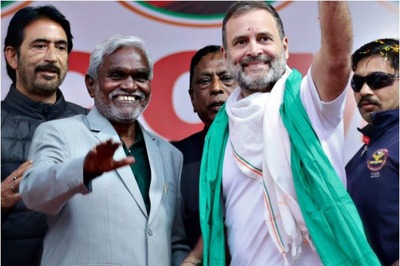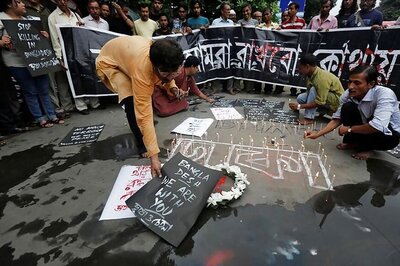
views
Guwahati: In a 10-day crackdown on northeast insurgent groups at the ‘Naga self-administered zone of Sagaing region and surrounding areas’, a recent release by the Office of the Commander-in-chief of Defence Services, Myanmar says that the Tatmadaw Kyee (Myanmar Army) have captured more outposts, arms and ammunition of Northeast rebels operating from their soil.
A release on February 3 states that the Tatmadaw could occupy two outposts and two training schools in the southwest of Takar village, one temporary outpost in the north, and one outpost in the west of Takar in a four-day long operation that started January 29. Another release on Wednesday states that the crackdown continues with the Tatmadaw columns taking security measures to ensure that illegal armed insurgent groups do not infiltrate into their territory.
The Tatmadaw have so far arrested six members of National Socialist Council of Nagaland (Khaplang faction), and two ‘Kathe’ (Manipuri) insurgents along with 11 small weapons of different kinds and a huge cache of ammunition including AK series rifles. The release also mentions that Tatmadaw took hold of the evidence that Kathe and Assam insurgents resided in Ta Ga (headquarters of most northeast militant groups) with the help of NSCN (K).
Future Strategy – ULFA (I) and NSCN-K?
With both the NSCN-K and the proscribed United Liberation Front of Assam (Independent) base camps under siege, it is now presumed that the militant outfits will possibly operate from the other adjacent camps in the area, with sources saying that ULFA (I) cadres including senior leaders had vacated the Ta Ga camp well before the siege.
Questions are being asked if the banned outfits might shift base to the Chinese border, a possibility ruled out by defence analysts.
“There have been many attacks by the Myanmar's army in NSCN and ULFA camps in the past. But despite heavy loss, these outfits have survived. The terrain of the region and anti-Myanmarese tribal environment helped them survive. It is unlikely that the rebel organisations will shift to Chinese side unless the region is saturated by the Myanmar army, which is logistically not possible at present. It will remain a type of attrition attack by the Myanmar army and their joint operations with the Indian army,” says former Assam Director General of Police in Assam, Harekrishna Deka.
“Logistically, the rebels are in a better position. It may be that the two armies will try to cut off all routes of the rebels and that may cause major difficulties for the rebels. If the army has some specific information of rebel camps, aerial attacks may wreck more destruction in rebel positions, if at all it an aerial mapping happened in this case is not known. Still, these groups will continue to be in Myanmar by shifting to new areas that may give them better human and logistic support,” he adds.
Strategic analyst and former DGP in Assam and Tripura, GM Srivastava maintains that ULFA (I) does not have camp in one location alone, but there are numerous camps in the same area. He says that the rebels can trek long distances for months together, but it is unlikely that they would move to the Chinese border.
“All cadres had moved out of the camp before this happened. Somebody must have leaked out the information and alternative arrangements must have been made. There was firing by Myanmar side, but that was probe fire, more to ensure their presence. There was no confrontation or collateral damage,” says Srivastava.
Myanmar Army Unable to Control Rugged Border
Long-time Myanmar observer and author of China’s India War: Collision Course on the Roof of the World (2018), Bertil Lintner believes that the Northeast insurgents would now move closer to the Indian border.
“There’s nowhere near the Chinese border they could have a proper camp. ULFA (I) chief Paresh Baruah is in Ruili in China, but there are no troops there. There are many rebel camps in and around Ta Ga, and a lot of camps in the surrounding mountains.”
The release by the Office of the Commander-in-Chief of Defence Services, Myanmar also states that ‘necessary action would be taken against NSCN-K for violating clauses in the preliminary agreement signed with the Sagaing Region Government for building peace, and that no opposing organisation to India would be allowed to reside in the Naga Self-Administered Zone.
“They said it right, but how will they enforce the ‘ban’ – that will remain a problem. It’s an extremely rugged area with few roads and virtually no government control,” says Lintner.
The Indo-Myanmar border is controlled by the Assam Rifles that operates Border Outposts (BOP) and Company Operating Bases (COB) along the border. While India continues to build road infrastructure up to the border, the same is lacking on the other side.
“The Myanmar army is unable to control and maintain the rugged border area. The normal practice has been to go into an area, hold it for few months and vacate, thus allowing insurgent groups to come back and set up bases again. They have tried to have separate ceasefire agreements with various rebel groups, who control the border areas, but have not been fully successful. The very presence of same ethnic groups on both side of the border prevent any short term solution,” says Kargil war veteran, retired Colonel Dilip Kumar Borah.
“Only when you have both side of the border fully developed and there is control over the drug trade, we can think of finally ousting these groups. Till then, this cat and mouse game will continue. We have to defeat these groups internally to make them an unattractive option for our youth,” he adds.
Positive Outcome of Indian Diplomacy
The Tatmadaw have Regional Military Commands and Light Infantry Divisions under the Commander-in-Chief of the Army, Regional Operation Commands (ROC) and Military Operation Commands (MOC). At a time when both Indian and Chinese agencies are trying to influence the various Tatmadaw divisions, the recent operation against Northeast rebels is being seen as a positive outcome of Indian diplomacy.
“As with the rest of Northeast, Myanmar remained out of focus of India till the first NDA government came to power under Atal Bihari Vajpayee. The Army ruled from 1962 to 2011 and may have been the main reason for this freeze. Though formal diplomatic relations remained, but India never pushed Myanmar to settle its insurgency problem,” says Col Borah.
Colonel Borah observes that military of both countries have, however, maintained close relationship and there has been continuous exchange of personnel for visit or training, India was also providing low level military help to the country.
“With the Chinese actively pursuing Myanmar for trade, defence cooperation, port facilities, road building, the Indian government finally woke up to the reality of being surrounded by hostile countries.
Presently India is heavily invested in Myanmar. We have taken up various developmental activities within Myanmar. Only thing we have asked in return is border security and controlling our insurgent groups unlawfully staying in their country."
With inputs from Biju Kumar Deka




















Comments
0 comment